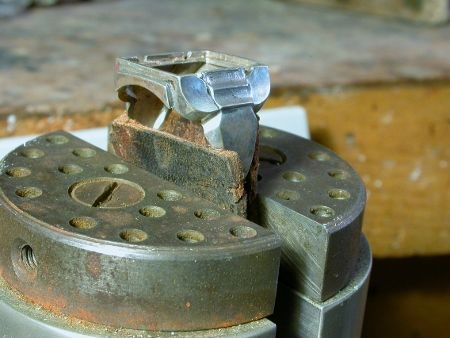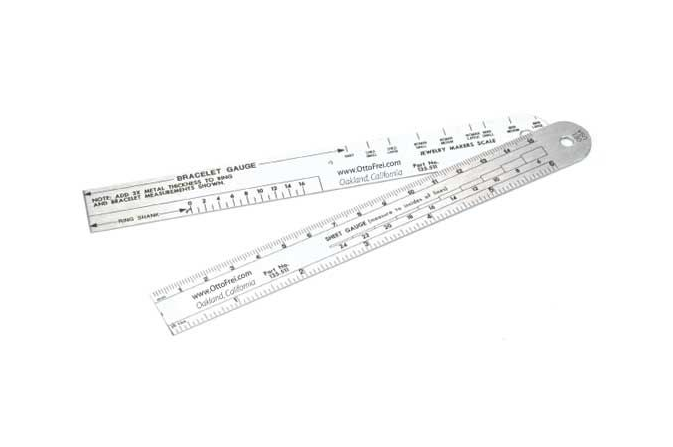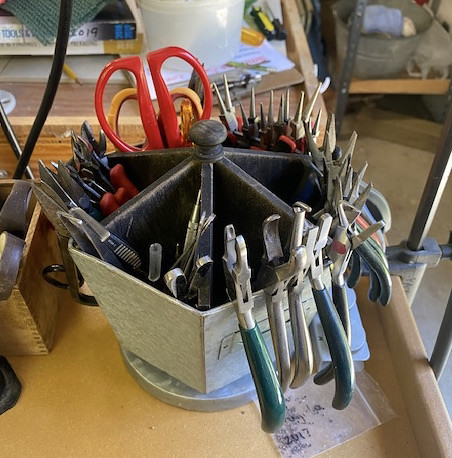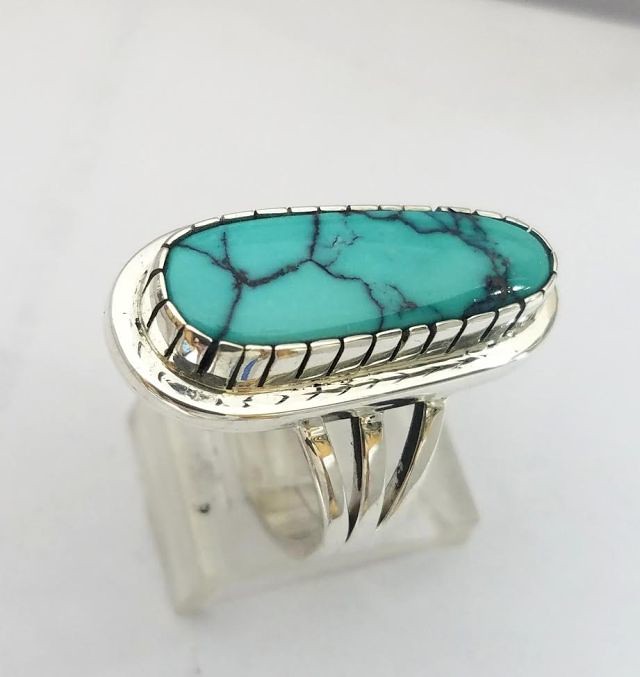Post up your favorite bench tools and accesories
Mar 11, 2017 13:41:24 GMT -5
micellular, RocksInNJ, and 1 more like this
Post by opalpyrexia on Mar 11, 2017 13:41:24 GMT -5
Have you ever tried thermoplastic? This is a favorite material that I use when setting stones and making dedicated karat/logo stamping blocks. I've also used small amounts of it to establish a "profile guide" against one part of a piece and then use it to scribe that profile on a mating piece that needs to be sawed and/or filed to fit that profile. I could not get along without it.
Although I haven't, often people use it to add custom hand-fitting grips to their tools. It's white and hard when solid at room temperature. Immerse it in hot water and it gradually becomes clear and pliable. We have an Insinkerator hot water dispenser in our kitchen, so I have to run upstairs for 175 degree water. Remove the plastic from the hot water using a wet wooden stick and, depending on the amount, you have up to a minute to shape it with your hands.
Here's a block of it that I use for pendant and some earring setting in an ancient engraving ball I acquired from an eBay auction. A vise would work,too. I remove the wooden block and hold the plastic over my alcohol lamp (not too close!) for about a minute. I may also give the jewelry piece a mild heating, and then push it into the plastic a bit. With a metal rod I push plastic up against the sides of the piece to secure it. Cool it and go to work knowing that the piece is held securely. When finished, hold the plastic and piece in hot water again to release it.
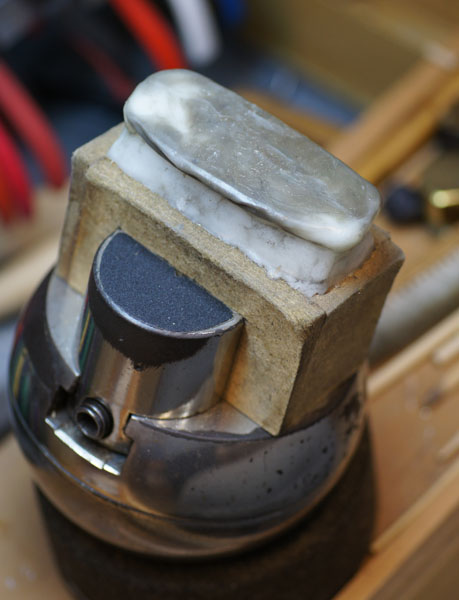
Thermoplastic is especially useful when setting stones in rings. This is an old workshop ring that I made. I fashion a ball from the heated plastic, shape it into a rough cylinder and insert it into the ring. Then I gently flatten the sides on a work surface. After the plastic cools and hardens, you can tighten it down securely in a vise and focus on setting and cleanup.
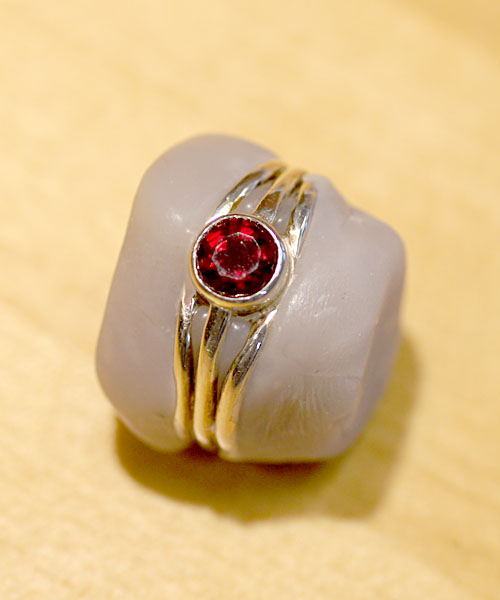
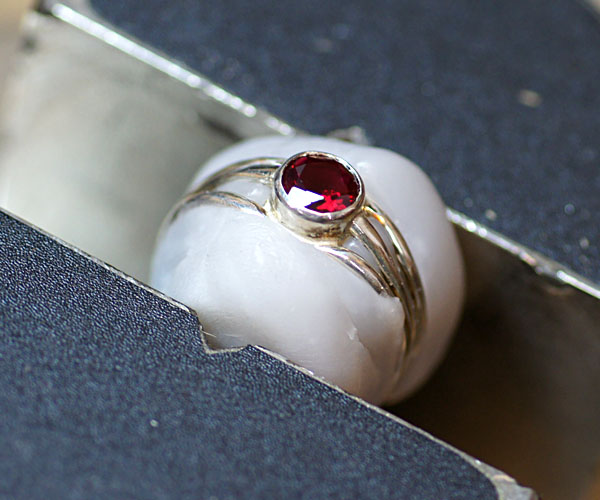
Yet another use that I've found is making custom karat or logo stamping blocks. This is especially useful if you cast multiples of the same item, but making a custom block is fast enough for one-off pieces, too. Here is a rough pendant casting that I make periodically. It has an irregular surface, so stamping the back is impossible without a mating block to support it. Using a bur I milled out an approximate cavity in a small block of polycarbonate plastic (high impact stuff). I then pushed a small amount of thermoplastic into it and then pushed one of my castings into that as hard as I could. The thermoplastic has some give to it, but there's so little of it here that stamping doesn't deform the silver. BTW, the thermoplastic loves plastics and sticks really hard to it.
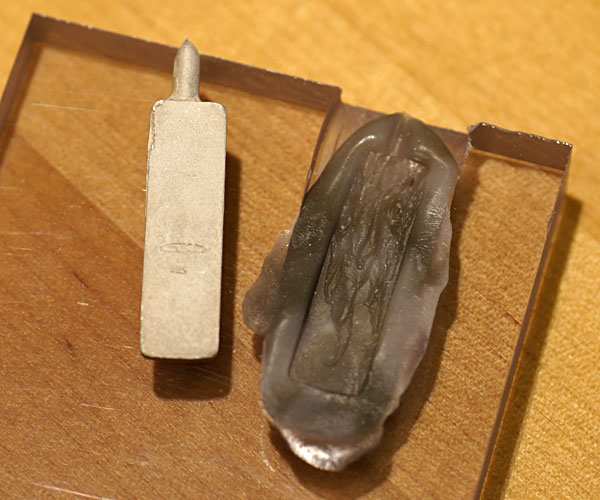
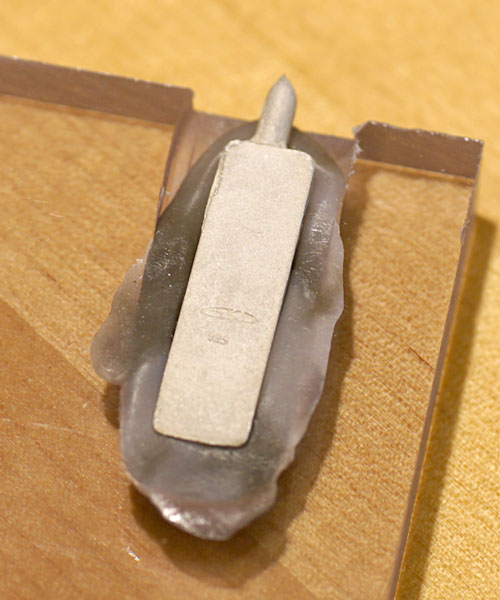
When it's time to put some plastic away for later use, be sure to soften it and flatten it very thin. That speeds up heating the next time. There are several listings for the stuff on Amazon and they all work basically the same.
Although I haven't, often people use it to add custom hand-fitting grips to their tools. It's white and hard when solid at room temperature. Immerse it in hot water and it gradually becomes clear and pliable. We have an Insinkerator hot water dispenser in our kitchen, so I have to run upstairs for 175 degree water. Remove the plastic from the hot water using a wet wooden stick and, depending on the amount, you have up to a minute to shape it with your hands.
Here's a block of it that I use for pendant and some earring setting in an ancient engraving ball I acquired from an eBay auction. A vise would work,too. I remove the wooden block and hold the plastic over my alcohol lamp (not too close!) for about a minute. I may also give the jewelry piece a mild heating, and then push it into the plastic a bit. With a metal rod I push plastic up against the sides of the piece to secure it. Cool it and go to work knowing that the piece is held securely. When finished, hold the plastic and piece in hot water again to release it.

Thermoplastic is especially useful when setting stones in rings. This is an old workshop ring that I made. I fashion a ball from the heated plastic, shape it into a rough cylinder and insert it into the ring. Then I gently flatten the sides on a work surface. After the plastic cools and hardens, you can tighten it down securely in a vise and focus on setting and cleanup.


Yet another use that I've found is making custom karat or logo stamping blocks. This is especially useful if you cast multiples of the same item, but making a custom block is fast enough for one-off pieces, too. Here is a rough pendant casting that I make periodically. It has an irregular surface, so stamping the back is impossible without a mating block to support it. Using a bur I milled out an approximate cavity in a small block of polycarbonate plastic (high impact stuff). I then pushed a small amount of thermoplastic into it and then pushed one of my castings into that as hard as I could. The thermoplastic has some give to it, but there's so little of it here that stamping doesn't deform the silver. BTW, the thermoplastic loves plastics and sticks really hard to it.


When it's time to put some plastic away for later use, be sure to soften it and flatten it very thin. That speeds up heating the next time. There are several listings for the stuff on Amazon and they all work basically the same.


